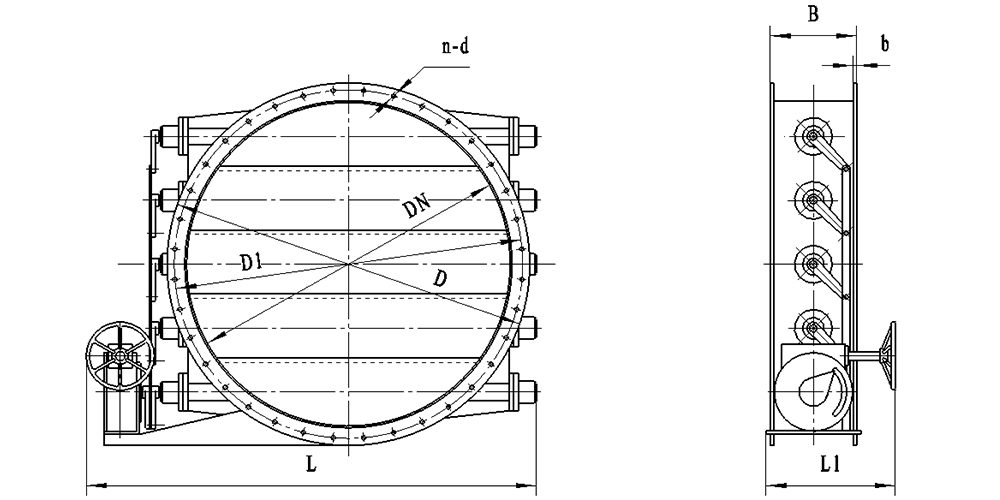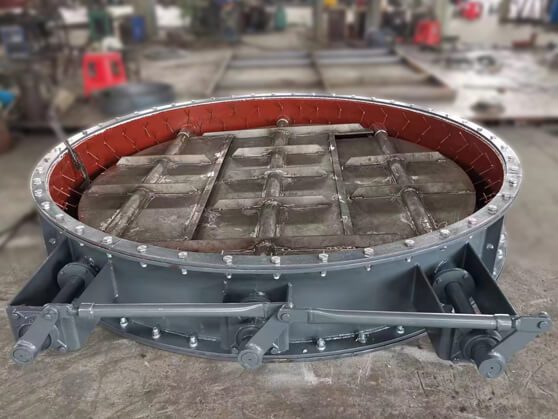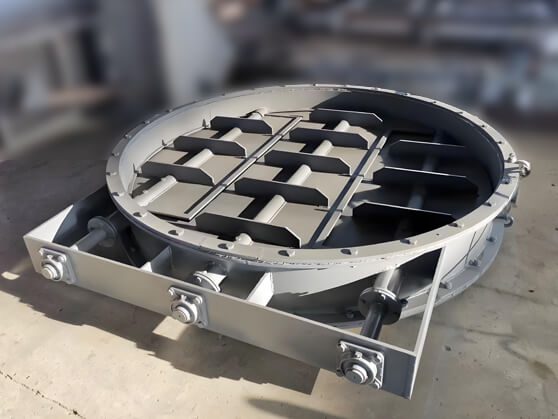Popular desigh
The design of the circular louver valve considers several features. These include high-temperature operation, lightweight opening and closing, and no leakage. The valve consists of multiple rotatable circular blades. This design allows for flexible adjustment of the opening angle, enabling precise control of gas flow in ventilation and dust removal pipelines.

Additionally, the circular louver valve offers several advantages. These include uniform flow, low operating torque, quick responsiveness, reliable performance, and large diameters. It is widely used in fans, air conditioning units, electrostatic precipitators, and various large pipelines. These applications help regulate and shut off dust and gas. In high-temperature environments, the circular louver valve performs exceptionally well. It can serve as a flow regulation or shut-off device for gas media in dust-laden cold or hot air pipelines. Furthermore, it works in conjunction with various actuators to form equipment with different performance characteristics.

Specification
|
Operating temperature |
-40~450℃ |
Use ambient temperature
|
Electric actuator: -10~55℃ |
|
|
Nominal pressure |
0.05MPa |
Hefu amplifier: 0~45℃ |
||
|
input signal |
0~10mA or 4~20mA |
ambient relative humidity |
Electric actuator: ≤95% |
|
|
voltage |
380V 220V 50HZ |
Hefu amplifier: ≤85% |
||
|
dead zone |
≤0.8% |
Material |
valve body valve plate |
Q235-A |
|
Return difference |
≤2.5% |
axis |
2Cr13 |
|
|
basic error |
±2.5% |
filler |
PTFE,Soft graphite |
|
How to choose a louver damper?
Operating Conditions
This includes factors such as operating temperature, pressure, and media properties. Different operating conditions require different materials and sealing methods. For example, high-temperature media require heat-resistant materials and packing, while dusty media need good sealing performance and ease of cleaning.
Control Method
Choose a valve based on the required control method, such as manual, electric, or other types. Electric control valves require appropriate power supply and signal input, and attention should be paid to the type, parameters, and installation method of the electric actuator.
Flow Characteristic
Select the appropriate flow characteristics based on the system’s flow requirements and adjustment range. Generally, circular louver dampers exhibit good linear characteristics, while rectangular louver dampers have better balancing characteristics.
Installation Method
Choose a suitable installation method based on the direction of the pipeline and available space. Typically, circular louver dampers can be installed either horizontally or vertically, while rectangular louver dampers are usually suitable for horizontal installation only.
Size and Weight
Select the appropriate size and weight based on the pipe dimensions and load capacity. Generally, circular louver dampers have larger diameters and lighter weights, while rectangular louver dampers tend to have smaller diameters but heavier weights.
What’s the difference between single and double layer of a circle louver valve?
A single-layer louver does not include sealing air and is designed for a sealing efficiency of 99%. The double-layer blades incorporate a sealed chamber for introducing sealing air. This allows sealing air, maintained at a pressure of 500 Pa above flue gas pressure, to flow into the damper. As a result, this creates a sealing air barrier between the double layers. This effectively blocks the passage of flue gases according to the designed sealing efficiency.
-
Design Structure:
- Single Layer: Consists of a single set of blades that control airflow. It is simpler in design and typically lighter.
- Double Layer: Features two sets of blades, creating an additional layer of airflow control. This design can enhance sealing and efficiency.
-
Sealing Performance:
- Single Layer: Generally has lower sealing efficiency, which may lead to more leakage, especially in high-pressure applications.
- Double Layer: Often incorporates a sealing chamber that allows for better sealing performance, reducing leakage significantly.
-
Airflow Control:
- Single Layer: Offers basic control over airflow but may not provide the same level of precision as a double layer.
- Double Layer: Provides more precise control of airflow due to the additional layer, allowing for better modulation and regulation.
-
Temperature and Pressure Handling:
- Single Layer: Suitable for moderate temperature and pressure conditions.
- Double Layer: Better equipped to handle higher temperature and pressure scenarios due to its enhanced design.
-
Applications:
- Single Layer: Typically used in less demanding applications where cost is a primary concern.
- Double Layer: Recommended for critical applications requiring high efficiency, precise control, and better sealing, such as in industrial ventilation and HVAC systems.
-
Cost:
- Single Layer: Generally more cost-effective due to its simpler design and materials.
- Double Layer: Usually more expensive due to the complexity of the design and the materials used.
Choosing Darko‘s round shutter valve will give you an efficient and durable fluid control device that will help you improve the overall performance and safety of your system. Whether in ventilation, air conditioning or industrial exhaust, this valve can provide you with reliable support.
For more information or technical consultation, please feel free to contact us, we will serve you wholeheartedly.


